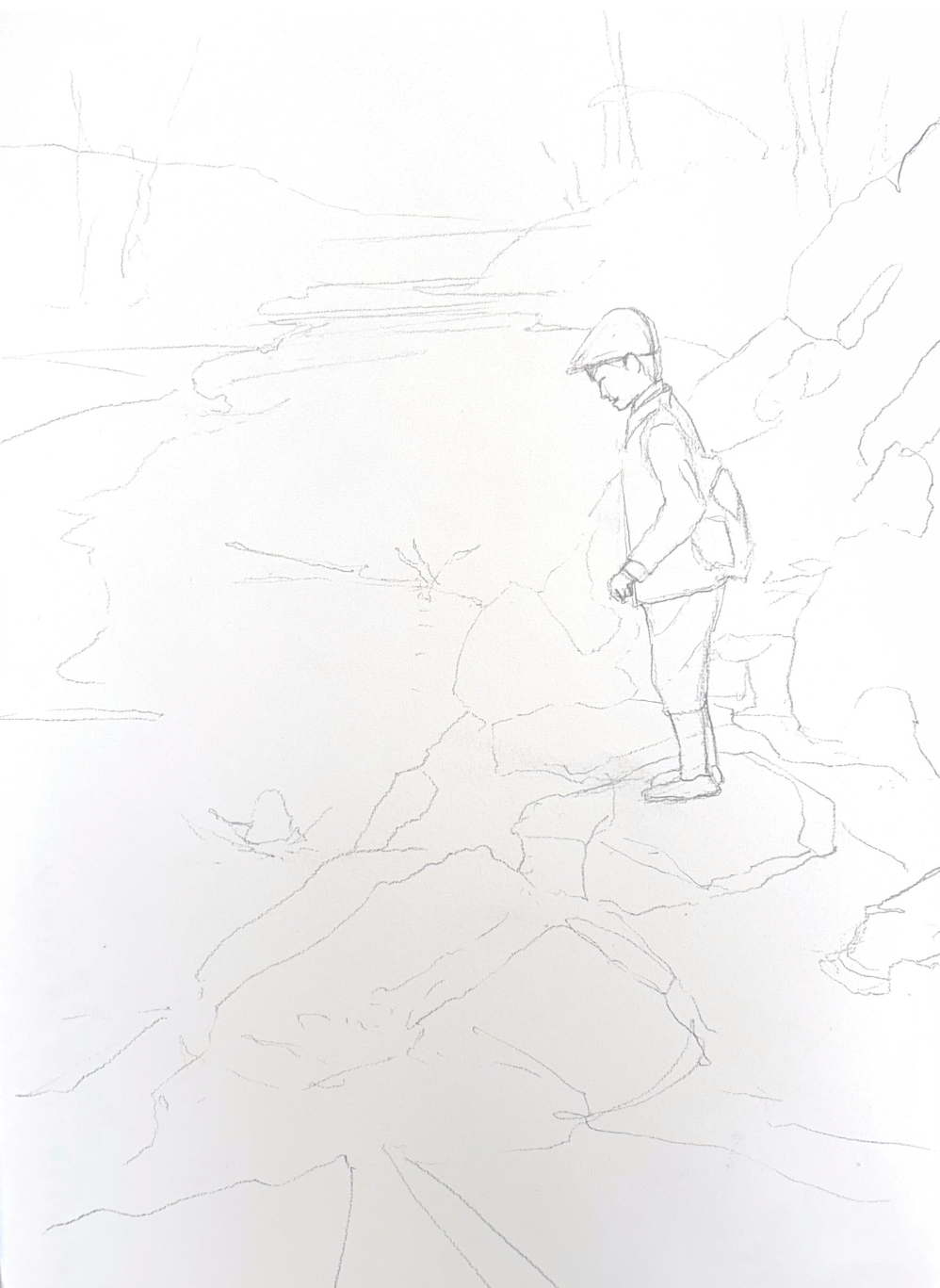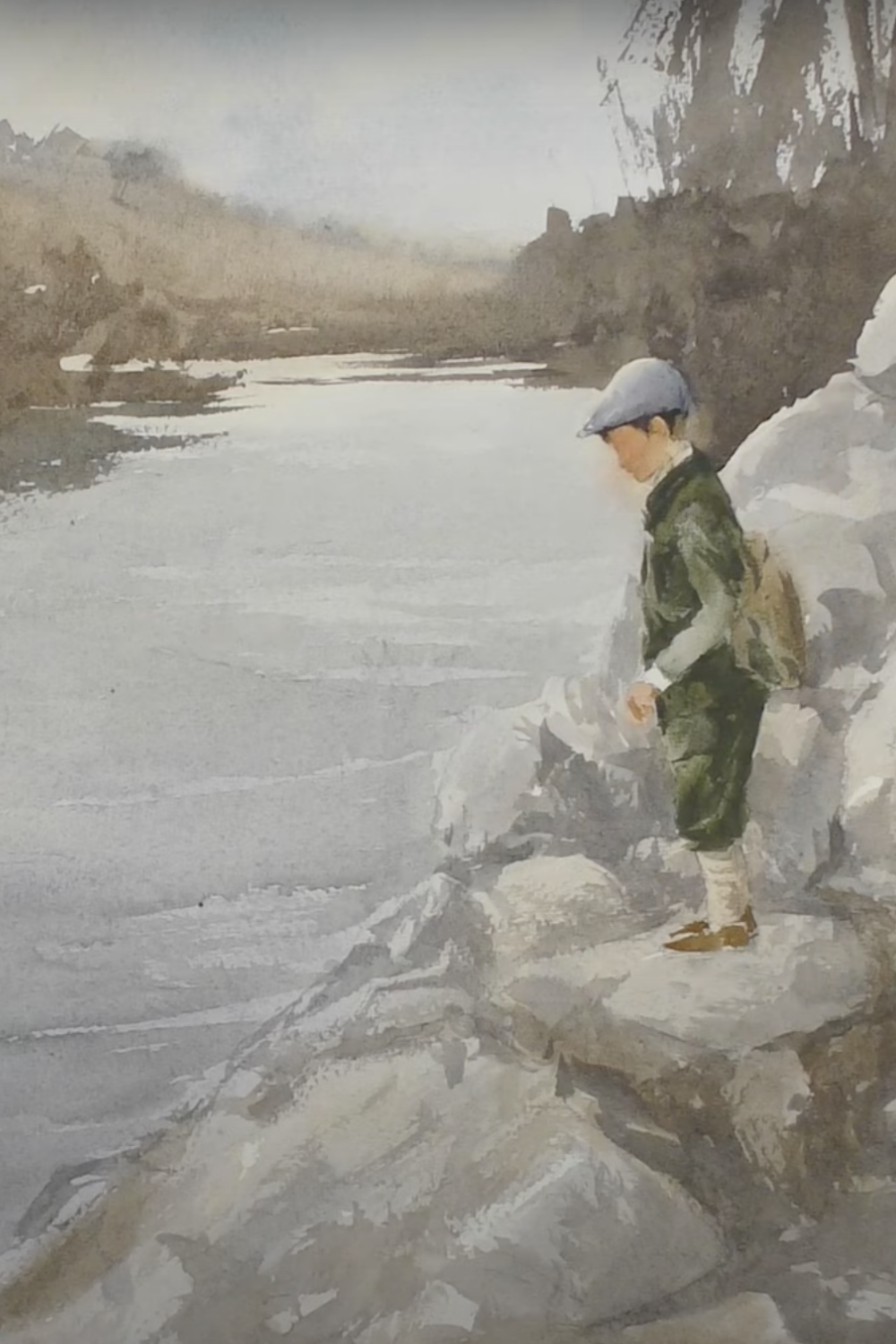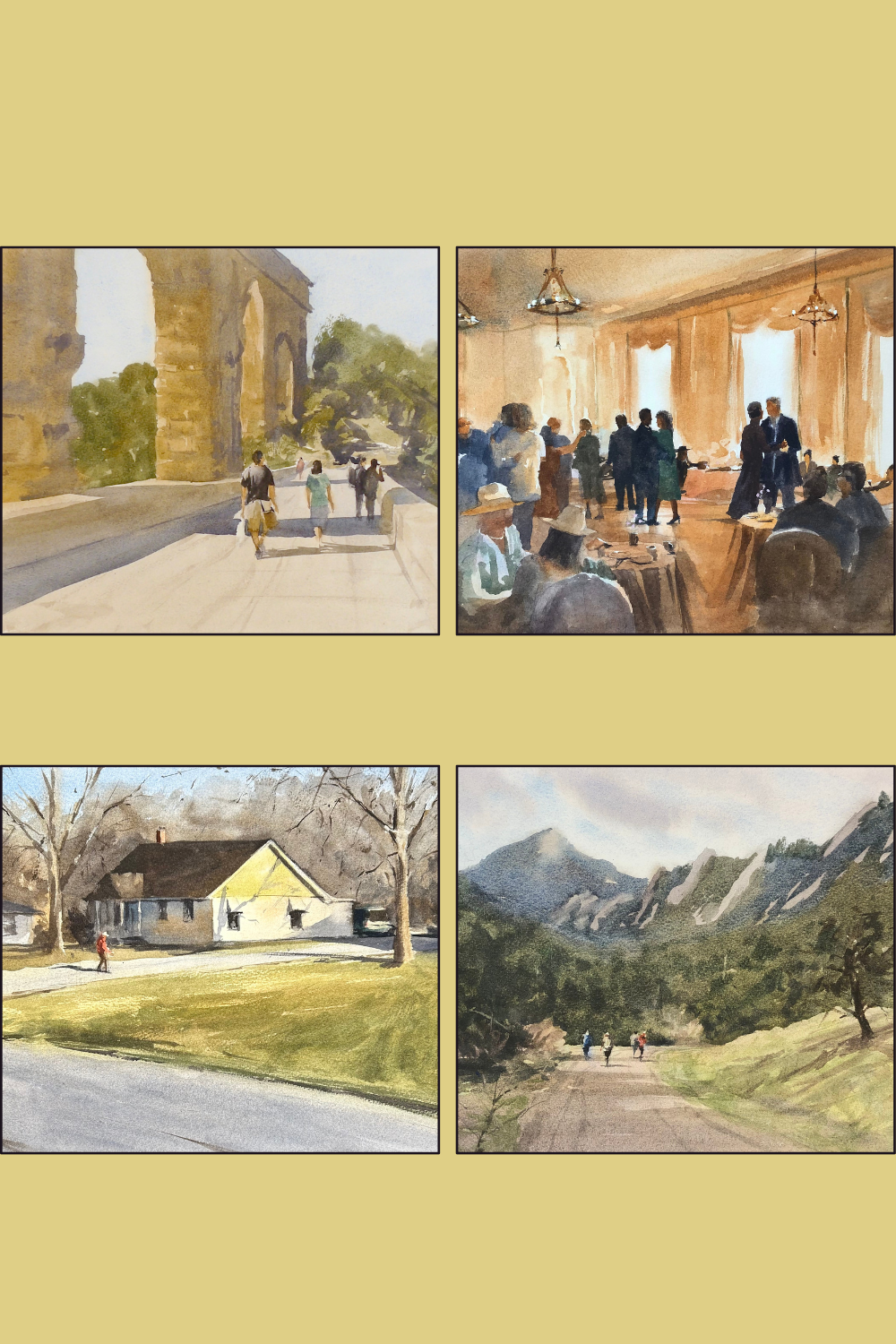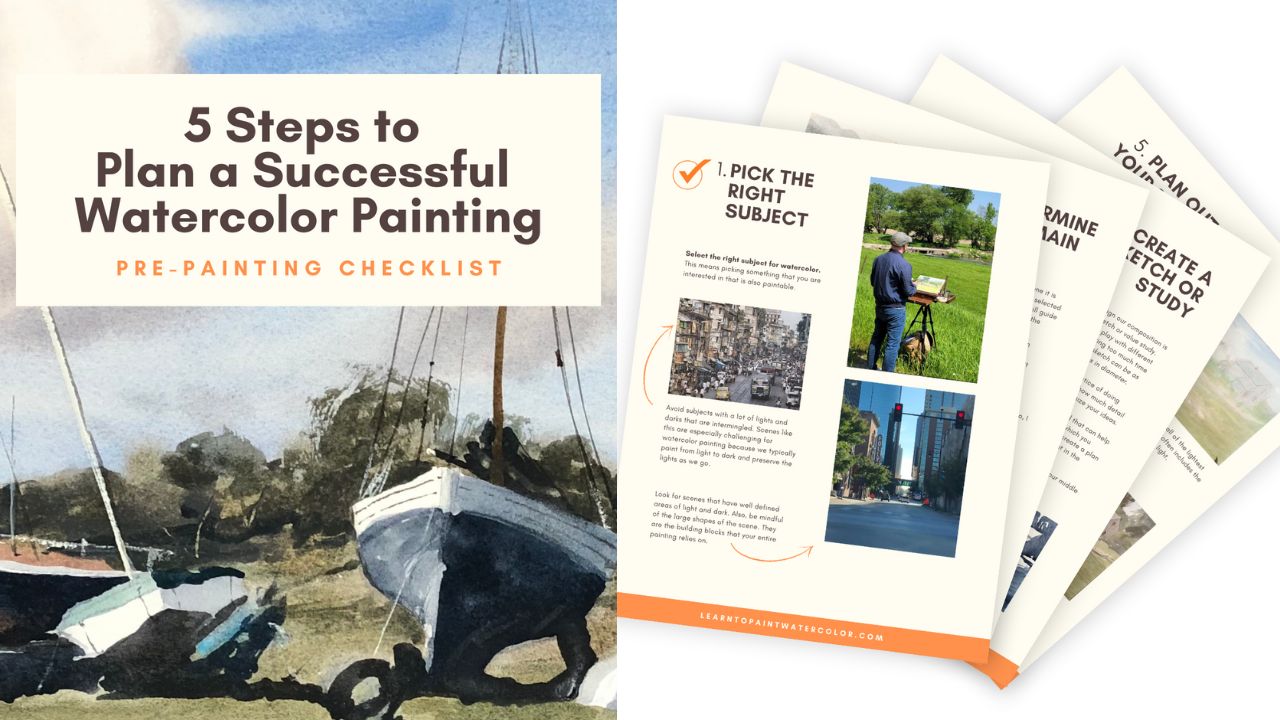Mastering the Art of Watercolor Landscapes
Apr 22, 2024Watercolor Landscapes become easier the more you can watch the watercolor painting process and practice watercolor techniques. That’s why today I am going to walk you through the steps I took to paint this watercolor featuring my son.
Step-by-step Watercolor Tutorial: A Special Landscape
Enjoy this Post? Like this Pin!

Some watercolor landscapes feature boats. Others feature barns, grazing sheep, or rock formations. This particular watercolor painting features my son (who loves to dress up like he’s from the past).
Painting people can be intimidating - especially ones you love. If you’re interested in painting watercolor portraits, a great way to practice proportion and life-like shape is by adding figures in your watercolor landscapes. It’s a great place to start.
To begin this watercolor landscape tutorial, you can use my drawing.

Feel free to print it out and outline it onto your paper. Or you can start with a blank piece of watercolor paper and draw your own figure!
3-Step Watercolor Landscape Paintings
The process that I teach is a three-step process:
1. After my drawing, I wet down the front and back of my paper. Then I do a wet-into-wet wash of the lightest values. In this painting, that means that I laid in the sky - just a hint of a sky because it is an overcast day - a little bit of color for the hills in the distance, the figure’s skin tone, and a gray wash behind the figure. When colors bleed into one another, I’m letting that happen and not worried about it.

2. The goal of my second wash is to find the connected shape. One of the big challenges when we paint is to find things that are connected instead of perceiving each element as separate from the other. Finding that connection strengthens your composition, enhances the shape of your painting, and allows some of your colors to flow into each other, which is a feature of watercolor paintings in particular.

3. Then, in the final wash, I add darks and details. You don't have a full sense of what the painting is until you get to this final stage where you're adding in the darks in the detail. They can really make or break a painting.

So if you're frustrated and you don't think the painting is working, definitely don't give up. Finish the painting and then see what you're left with. You might be surprised by the results.
Painting from light to dark
While some watercolor artists paint from dark to light in some instances, you’ll find that most paint from light to dark. Due to the transparency of the paints, each successive wash shows the colors that were applied in previous washes. And dark watercolor pigments cover light pigments much better than the reverse.
It is very difficult (if not impossible) to regain a lighter value after you’ve laid down a dark value in watercolor. So in order to have a broad spectrum of values that play off one another, the best method is to start light and lay in the darker values in later washes.
Maintaining Focus on Your Main Idea/Focal Point
One takeaway I’d like to note about this landscape painting is that the background of my reference photo is much more complicated than the one I painted. This is purposeful.

My focal point is the figure - my son. And when I planned this painting, I wanted to make sure that the most interest, the most contrast, and the most detail were near him. If I were to overcomplicate the trees in the background - or match the value from the picture, they would compete with my main idea.
Always feel free, when you are painting from a reference, to take these small artistic liberties in the interest of your painting. Think about what is best for your composition, lighting, and what will best serve your main idea. When you try to retain every last detail of a watercolor landscape, you often end up overworking the painting.
What Supplies Did I Use to Paint this Watercolor Landscape?
I am painting on Saunders Waterford Cold Press 140lb paper. I have my surface tilted to 35 degrees. I use a variety of brands of brushes. I mainly stick to a large mop, medium round brush, and a smaller synthetic brush with a point.
Here are the list of pigments on my palette:
- Burnt Sienna
- Cadmium Red
- Cadmium Yellow Medium
- Cerulean Blue
- Cobalt Blue
- Cobalt Teal Blue
- Cobalt Turquoise
- Lavender
- Neutral Tint
- Payne's Gray
- Quinacridone Gold
- Raw Sienna
- Raw Sienna Light
- Raw Umber
- Rose Madder Permanent
Why Paint Watercolor Landscapes That Include Figures?
Landscapes on their own, without figures, can be gorgeous. A landscape does not necessarily need figures, but they add quite a bit to a watercolor scene that you maybe haven’t considered.
1. People in a scene tell a story.
There is nothing more compelling than a good story, and adding people to your painting gives you the opportunity to do just that. Among the many ways we attract and keep viewers in our paintings is suggesting a storyline. Just placing figures in your painting poses questions like, what’s their relationship? What are they discussing? Or, in my example today, a viewer might ask what has motivated this kid to dress this way? What imaginative world is he in? Questions like this are good. They generate interest around your painting. And ultimately, this is what we want.

2. A figure in your scenes acts as a scale for the rest of your painting.
Imagine the painting with my son without him in it. Envision it with just the rocks, the pond, and the background trees and sky. Taking him out of the painting also takes away a clue about how to interpret this painting. The size of the rocks becomes less defined, the length of the pond becomes less obvious.
The painting would likely still work without him. There are other elements that aid in the overall proportions, but a figure brings a familiarity unlike anything else. It lends a scene believability and scale.

3. People added to a watercolor painting bring the scene to life.
People bring a unique flair to a painting. They add their particular personality as expressed in their clothing, their posture, and their expressions. They also provide a peek into the culture of a locale, add to the mood of the painting, and suggest what daily life is like for certain people.
In this way, figures elevate a landscape scene from mere description to an active, lively scene. They offer personality and verve. And they require your viewer to engage and imagine with you.
Follow Along With My Watercolor Landscape Video
If you’ve made it down to the end of the blog and want more information, you might find the video at the top of this page even more informative (or click here!). Watch my painting come together, step by step, along with my commentary on my watercolor process.
Start Painting Better Landscapes Today!
Have you ever been really excited about a landscape painting? You get all set up. You find that right reference that you're excited about, and then it's time to go... but you feel lost.
Maybe you're having a hard time achieving consistency. Some of your paintings turn out, some of your paintings don't turn out. And you're not really sure why.
Well, I have a free resource that I want to offer you that will help with these exact problems: my Five Steps to Plan a Successful Watercolor Painting.
In this free lesson, I walk you through the crucial planning phase of your painting that will help you understand what you're going to paint first, second and third.
Planning is so important, especially in watercolor. This medium is harder to correct. It's so immediate. So having that plan is essential.
After you sign up, I will send you a free PDF that you can have on your phone or computer. Or you can print it out and use a hard copy.
Then you can take a look at these crucial pre-painting steps before you start each painting - landscape or otherwise - to ensure that you're asking yourself the right questions as you get started.
Related Blogs
Dive into the Serenity of Landscape Painting with our Guided Watercolor Tutorial
How to Prepare for a Smooth and Successful Painting Session
Paint this Glowing Landscape in Watercolor
